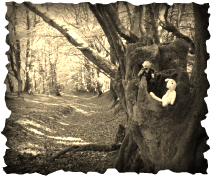
Surveying Dead Woman's Ditch.

The woods of coppiced oak where John Walford plied his trade as a charcoal burner.
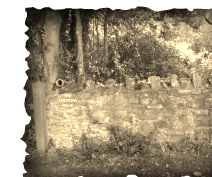
The 'Counting House' in the grounds of which John Walford likely murdered his wife, still stands to this day.
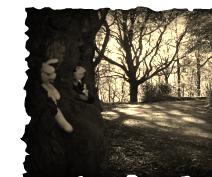
The blind corner known locally as 'Gibbet's Elbow' at the point on the old coach road where John Walford was hanged and gibbeted.
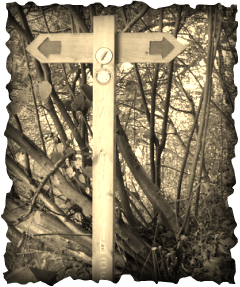
Marker post at Walfords Gibbet.
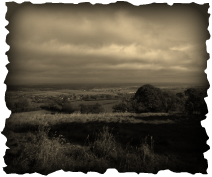
The spectacular view from Walfords Gibbet, we could see Wales from here on this beautiful day.
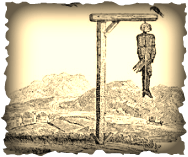
Dead woman’s ditch is an ancient monument near the picturesque village of Over Stowey in Somerset on the Quantock hills, it is thought to be a boundary ditch relating to Dowsborough Hill fort dating back to the Iron Age.
Local folklore has it that it gained its name after a brutal murder that occurred in the area on the fourth of July 1789. John Walford beat his wife almost to death with a hedge post, then with ruthless efficiency, he cut her throat using sufficient force to score the bone in her neck. Jane Walford (nee Shorney), was heavily pregnant with John’s child.
However, although it is true that this horrid crime took place within a short distance of the ditch, (probably in the grounds of the local copper mine’s Counting House), Jane’s corpse was not discovered in any part of the ditch. Furthermore, there exists at least one map dated 1780, nine years before the event, that mentions Dead Woman’s Ditch.
It is possible this beautiful spot was given its macabre moniker hundreds of years before the birth of the ill-fated Jane Shorney, It is indeed an atmospheric place, its steep combes are smothered in forests of coppiced sessile oak. During the lifetime of John Walford, it was described as deep, dark, damp, misty and primeval, and, it was believed to be inhabited by fairies and ghosts. Folklore also tells of bloody Celtic battles and even Pirate raiders.
The roots of this forest are steeped in rivers of blood, and whoever the eponymous dead woman is, her name will remain forever lost to history. Considering then, what moulders beneath, cocooned forever in the grasping roots of these trees, I would counsel against collecting timber from this place to burn on your hearth, there is no telling what you may release. Indeed I wonder what John Walford may have unleashed here during his years of lonely nights spent in the remote parts of the forest as a charcoal burner.
Walk a little further up the old coach road however and you will discover the very aptly named ‘Walford’s Gibbet’. This is the spot where a thirty foot gibbet was raised from which to hang John Walford for his crime, not only was he executed on Thursday 20th August, the sentence was changed to ‘hanging in chains near to the place where the offence was committed’, which meant he would be hanged and his body put on display in an iron cage on the gibbet.
So it was that John Walford was hanged on a temporary gallows after admitting to his crime, but insisting, ‘I did it without foreintending it’. After hanging for twenty minutes, the corpse was taken down, locked into the iron cage and hoisted to the top of the gibbet. It is worth noting the gibbet was a quarter of a mile from John’s parent’s house and directly opposite it, so over the next year each time his parents opened their front door, they were greeted with their son’s body hanging on the hill before them.
Walford hung in the iron cage, dancing and desiccating in the wind, delineated against the sky for all to see until precisely a year to the day after the murder, (which is in itself an unsettling detail), the cage came loose from the gibbet and crashed to the ground. Local people buried him ten feet deep on the spot where he fell.
If you are looking for an example of the restless dead, come to Walford’s Gibbet, you may hear him, stamping about and whining because he still believes his crime was somehow justified, a weak, cowardly man in life who murdered his wife because she was inconvenient, he remains so in death.
Two are required to make the beast with two backs, that is undeniable, and Jane Shorney must bear some part of the responsibility for producing at least two bastards, one by John Walford, another by John’s brother, William, and carrying another by John that was weeks from birth at the time of her murder. However, John was no fool, he was described at the time by no less a man than Thomas Poole (local business man and associate of Samuel Taylor Coleridge) as ‘breathing intelligence’, therefore, there can be no doubt he would have been perfectly aware of the potential consequences of his actions. Jane Shorney however was described (also by Thomas Poole) as ‘a poor, stupid creature, almost an idiot’. This leaves me in little doubt as to who was the victim in this grim scenario.
Illegitimate pregnancy could result in a public flogging for the mother until 1742, and thereafter would result in terrible disgrace, a bastard was a burden on the parish, and the Overseers of the Poor had the power to arrest the father and if he would not give security to release the parish of its burden, or agree to marry the mother, they could imprison him.
It seems to me therefore, that having previously sired one other bastard with Jane Shorney, a child which his mother had provided security for on his behalf, he should have had the sense to keep his wick dry.
So John was arrested once more, and being too proud to ask his mother to help once more, he agreed to marry Jane Shorney, seventeen days later she was dead.
John Walford made his choices, he chose to partake in intercourse with Jane Shorney, nobody forced him, he chose to end her life when he could have simply run away to London, as he had at one time planned to do, his choices would have consequences, he knew this. At the time, the consequence of murder was state sanctioned murder for the perpetrator.
Accept it John, move on.
Local folklore has it that it gained its name after a brutal murder that occurred in the area on the fourth of July 1789. John Walford beat his wife almost to death with a hedge post, then with ruthless efficiency, he cut her throat using sufficient force to score the bone in her neck. Jane Walford (nee Shorney), was heavily pregnant with John’s child.
However, although it is true that this horrid crime took place within a short distance of the ditch, (probably in the grounds of the local copper mine’s Counting House), Jane’s corpse was not discovered in any part of the ditch. Furthermore, there exists at least one map dated 1780, nine years before the event, that mentions Dead Woman’s Ditch.
It is possible this beautiful spot was given its macabre moniker hundreds of years before the birth of the ill-fated Jane Shorney, It is indeed an atmospheric place, its steep combes are smothered in forests of coppiced sessile oak. During the lifetime of John Walford, it was described as deep, dark, damp, misty and primeval, and, it was believed to be inhabited by fairies and ghosts. Folklore also tells of bloody Celtic battles and even Pirate raiders.
The roots of this forest are steeped in rivers of blood, and whoever the eponymous dead woman is, her name will remain forever lost to history. Considering then, what moulders beneath, cocooned forever in the grasping roots of these trees, I would counsel against collecting timber from this place to burn on your hearth, there is no telling what you may release. Indeed I wonder what John Walford may have unleashed here during his years of lonely nights spent in the remote parts of the forest as a charcoal burner.
Walk a little further up the old coach road however and you will discover the very aptly named ‘Walford’s Gibbet’. This is the spot where a thirty foot gibbet was raised from which to hang John Walford for his crime, not only was he executed on Thursday 20th August, the sentence was changed to ‘hanging in chains near to the place where the offence was committed’, which meant he would be hanged and his body put on display in an iron cage on the gibbet.
So it was that John Walford was hanged on a temporary gallows after admitting to his crime, but insisting, ‘I did it without foreintending it’. After hanging for twenty minutes, the corpse was taken down, locked into the iron cage and hoisted to the top of the gibbet. It is worth noting the gibbet was a quarter of a mile from John’s parent’s house and directly opposite it, so over the next year each time his parents opened their front door, they were greeted with their son’s body hanging on the hill before them.
Walford hung in the iron cage, dancing and desiccating in the wind, delineated against the sky for all to see until precisely a year to the day after the murder, (which is in itself an unsettling detail), the cage came loose from the gibbet and crashed to the ground. Local people buried him ten feet deep on the spot where he fell.
If you are looking for an example of the restless dead, come to Walford’s Gibbet, you may hear him, stamping about and whining because he still believes his crime was somehow justified, a weak, cowardly man in life who murdered his wife because she was inconvenient, he remains so in death.
Two are required to make the beast with two backs, that is undeniable, and Jane Shorney must bear some part of the responsibility for producing at least two bastards, one by John Walford, another by John’s brother, William, and carrying another by John that was weeks from birth at the time of her murder. However, John was no fool, he was described at the time by no less a man than Thomas Poole (local business man and associate of Samuel Taylor Coleridge) as ‘breathing intelligence’, therefore, there can be no doubt he would have been perfectly aware of the potential consequences of his actions. Jane Shorney however was described (also by Thomas Poole) as ‘a poor, stupid creature, almost an idiot’. This leaves me in little doubt as to who was the victim in this grim scenario.
Illegitimate pregnancy could result in a public flogging for the mother until 1742, and thereafter would result in terrible disgrace, a bastard was a burden on the parish, and the Overseers of the Poor had the power to arrest the father and if he would not give security to release the parish of its burden, or agree to marry the mother, they could imprison him.
It seems to me therefore, that having previously sired one other bastard with Jane Shorney, a child which his mother had provided security for on his behalf, he should have had the sense to keep his wick dry.
So John was arrested once more, and being too proud to ask his mother to help once more, he agreed to marry Jane Shorney, seventeen days later she was dead.
John Walford made his choices, he chose to partake in intercourse with Jane Shorney, nobody forced him, he chose to end her life when he could have simply run away to London, as he had at one time planned to do, his choices would have consequences, he knew this. At the time, the consequence of murder was state sanctioned murder for the perpetrator.
Accept it John, move on.
 RSS Feed
RSS Feed